#E-Learning Software
Explore tagged Tumblr posts
Text
Data-Driven Learning: E-Learning Analytics and Software Development Services
In the dynamic landscape of education, the integration of data-driven learning has emerged as a transformative force, reshaping how learners engage with content and educators refine their teaching strategies. At the heart of this evolution are E-Learning Analytics and Software Development Services, working in tandem to harness the power of data for informed decision-making and personalized learning experiences. This exploration delves into the significance of data-driven learning, the role of E-Learning Analytics, and the collaborative efforts of Software Development Services in shaping the future of education.

1. Unleashing the Power of Data in Education
a. The Paradigm Shift: The traditional model of education often operated on a one-size-fits-all approach. Data-driven learning represents a paradigm shift, recognizing that each learner is unique. By harnessing data, educators can tailor instructional approaches to meet individual needs, fostering a more effective and personalized learning experience.
b. The Role of Technology: E-Learning Software Development Services serve as the backbone of data-driven learning. These services create the digital infrastructure that captures, analyzes, and interprets data generated within the learning environment. The integration of advanced technologies, including Artificial Intelligence (AI) and machine learning, enhances the capabilities of these platforms.
2. E-Learning Analytics: The Pillar of Data-Driven Learning
a. Defining E-Learning Analytics: E-Learning Analytics involves the collection, analysis, and interpretation of data generated by learners within digital platforms. It encompasses a range of metrics, from engagement patterns and assessment performance to the effectiveness of instructional content.
b. Informing Instructional Design: E-Learning Analytics provide valuable insights into how learners interact with content. Software Development Services integrate analytics tools that track user behavior, enabling educators to refine instructional design based on real-time data. This iterative approach enhances the effectiveness of learning materials.
c. Identifying Learning Trends: By aggregating and analyzing data from diverse learners, E-Learning Analytics identify overarching learning trends. This information guides educators in understanding which strategies are most successful and informs decisions on curriculum adjustments and pedagogical enhancements.
3. Personalization through Data Insights
a. Adaptive Learning Paths: E-Learning Software Development Services leverage data insights to create adaptive learning paths. These paths adjust in real-time based on individual learner performance, ensuring that each student receives content tailored to their proficiency level and learning style.
b. Predictive Analytics: Predictive analytics, an advanced feature of E-Learning Analytics, uses historical data to forecast future learner performance. By identifying potential challenges or areas of struggle, educators can proactively intervene, providing additional support and resources.
c. Customized Learning Experiences: The collaboration between E-Learning Analytics and Software Development Services enables the creation of highly customized learning experiences. From content recommendations to interactive modules, learners benefit from a personalized journey that aligns with their strengths and areas for improvement.
4. Real-Time Feedback for Continuous Improvement
a. Timely Assessments: E-Learning platforms equipped with analytics tools provide real-time feedback on learner assessments. Educators can promptly identify areas of difficulty, allowing for timely intervention and targeted support.
b. Iterative Curriculum Design: Data-driven insights inform iterative curriculum design. E-Learning Software Development Services facilitate the incorporation of new content, interactive elements, and multimedia based on the evolving needs and preferences of learners, creating a dynamic and responsive educational environment.
c. Professional Development for Educators: E-Learning Analytics also extend to professional development for educators. Data insights help identify areas where educators can enhance their instructional strategies, fostering a culture of continuous improvement.
5. Enhancing Student Engagement and Retention
a. Identifying Engagement Patterns: E-Learning Analytics track user engagement patterns, identifying elements that capture learner interest. Software Development Services integrate features that enhance engagement, such as interactive simulations, gamification elements, and multimedia content.
b. Early Warning Systems: Predictive analytics within E-Learning platforms serve as early warning systems. By detecting signs of disengagement or potential dropout indicators, educators can intervene to re-engage learners and address any underlying challenges.
c. Gamification for Motivation: Gamification elements, facilitated by Software Development Services, contribute to learner motivation. Badges, points, and leaderboards create a gamified environment, making the learning journey more enjoyable and incentivizing active participation.
6. Addressing Challenges and Ethical Considerations
a. Data Security and Privacy: As the collection of learner data becomes more prevalent, ensuring data security and privacy is paramount. E-Learning Software Development Services implement robust security measures and adhere to privacy regulations to safeguard sensitive information.
b. Ethical Use of Data: Ethical considerations in the use of learner data are critical. E-Learning Analytics should prioritize transparency, informed consent, and responsible data practices. Software Development Services play a pivotal role in designing platforms that uphold ethical standards.
c. Balancing Quantitative and Qualitative Data: While quantitative data provides valuable metrics, the qualitative aspect is equally important. E-Learning Software Development Services incorporate features that allow for the collection of qualitative feedback, ensuring a holistic understanding of the learner experience.
7. Future Trends in Data-Driven Learning
a. Emphasis on Learning Analytics Literacy: Educators and learners will likely develop increased literacy in interpreting learning analytics. Training programs and resources within E-Learning platforms may focus on enhancing the ability to derive meaningful insights from data.
b. Integration of Augmented Reality (AR) and Virtual Reality (VR): The integration of AR and VR technologies could enhance data-driven learning experiences. Immersive simulations and virtual labs may provide additional layers of data for analysis, contributing to a more comprehensive understanding of learner interactions.
c. AI-Driven Personalized Learning Paths: AI algorithms may play an even more significant role in shaping personalized learning paths. E-Learning Software Development Services might evolve to incorporate advanced AI models that adapt and recommend content based on real-time learner interactions.
Conclusion: Shaping the Future of Education
As data-driven learning becomes increasingly integral to education, the collaboration between E-Learning Analytics and Software Development Services serves as the engine driving innovation. The ability to harness data for personalized learning experiences, continuous improvement, and informed decision-making positions these technologies at the forefront of shaping the future of education. Through a careful balance of technology, ethical considerations, and learner-centric design, the synergy between data-driven learning and software development paves the way for a more adaptive, responsive, and effective educational landscape.
0 notes
Text
#Educational Website Development#Online Learning Platforms#Educational Technology Solutions#E-Learning Web Development#E-Learning Software#Website Development for Educators#MathYug Technologies#Mathyug
0 notes
Text
E-learning content Development Company in Hyderabad Code and Pixels
E-Content development
At Code and Pixels, we believe that great training begins with great content.
Code and Pixels provides customised and current learning content that makes you stay competitive — right from knowledge transfer of company processes and systems to product information. Such technically heavy and complex content becomes a challenge for the trainer to deliver and difficult for end users to consume in conventional training formats. Hence,
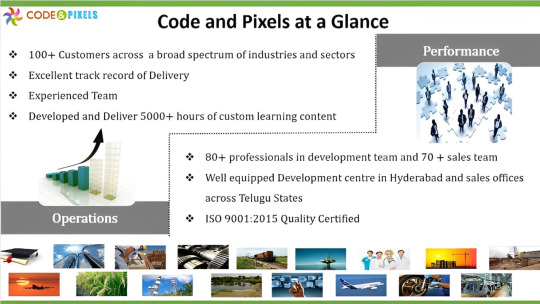
We develop custom E-learning content which is:
Sound using instructional design principles and pedagogy
Compliant with international E-learning standards
A combination of multiple media — games, quizzes, tests, simulations, video, animation, audio and graphics.
Compatible and runs on any standard Learning Management System (LMS)
Highly interactive and enables tracking and scoring of each learner’s progress
Multilingual
We employ a multitude of technologies and tools like graphics, animations, audio-visuals, interactive games and activities that help in giving the right information in the right manner to the right audience.
Mobile Learning/HTML 5
We are living in a multi-device world. We now have options to deliver eLearning using a wide variety of devices such as desktops, laptops, tablets and smart phones. Whether it is for smart phones or tablets — using platforms like Android, BlackBerry or iOS– we develop any kind of solution which suits your mobile learning needs perfectly.

What Is HTML5?
HTML5 is the newest hyper text markup language for websites from the World Wide Web Consortium (W3C). The first draft was made public in 2008, but not much happened until 2011. In 2011, HTML5 was released and people started writing about it and using it, but the support in different browsers was still poor. Today all major browsers (Chrome, Safari, Firefox, Opera, IE) offer HTML5 support, therefore the newest HTML technology can be used at its best today.
Major browsers
IE9+, FF4+, Safari5+, Opera11+, Chrome10+, Blackberry Browser, Silk
Platforms
iOS, Android, ChromeOS, BlackberryOS, Symbian, Windows Mobile 7.5+
Libraries
Webkit (Google, Apple, etc.), Gecko (Mozilla), Trident (Microsoft), Presto (Opera)
A reality indeed. As HTML5’s impact continues to ripple, many companies are dealing with the necessity of abandoning Flash applications. HTML5 is more flexible, allows movement, doesn’t affect SEO and doesn’t need a plug-in.
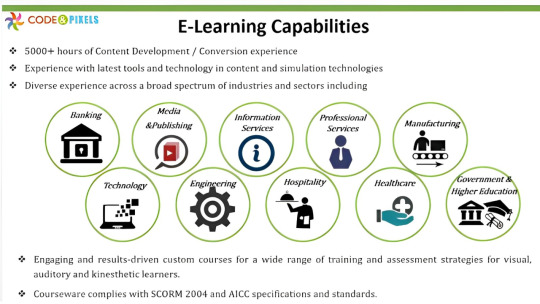
The migration of Flash eLearning courses to HTML5
eLearning, Training, Media organizations andmarketing departments of all kinds of companies have huge volumes of Interactive Flash content that has traditionally been consumed on desktops. With the rapid proliferation of smart phones and tablets, enterprises are faced with the prospect of their existing content becoming obsolete, since popular mobile platforms don’t support Interactive Flash.
While new content can be developed on a platform an industry standard format like HTML5, ground-up redevelopment of existing Interactive Flash content for mobile devices is not an option for most enterprises. What they need is a high-quality yet rapid solution for migrating their legacy of Interactive Flash content to HTML5.
Flash to HTML5 Migration
We shall take your existing Interactive Flash content and use the Flash to HTML Framework to re-purpose it to make it usable and HTML5 content that is suitable for a variety of devices including desktops, smart phones & tablets.
Powered by HTML5, CSS3 and JavaScript, our Flash to HTML5 framework enables us to accelerate speed-to-market for the new HTML5 content while preserving the richness of the original Flash content.
The new HTML5 content is able to fulfill the greater demands on usability posed by the varying screen sizes and resolutions of mobile devices. Recognizing that mobile devices don’t always have the same processing horsepower of desktops, our migration/conversion process leverages our framework to ensure that the repurposed HTML5 can perform on the most popular mobile platforms.
The framework adheres to content standards and supports various fundamental interactive behaviors like programmed workflows, directional information, enhanced content Menus, Multimedia Content Delivering, 2D Animations, Voice Synchronization, Interactivity, Status Bar, Volume Controllers, Slide Bar, Bookmark, Search, Standard navigation features i.e. Next, Previous, Menu amongst several others
With mobile devices being used and preferred for numerous multimedia applications, we shouldn’t forget something that Apple first pointed out. Flash does use too much processing and battery power; something that makes it disadvantageous. So migration to HTML becomes unavoidable.
In a continuously changing and fast paced environment, we can’t chain users to their desks and offices. So the creation of HTML5 eLearning applications, training material, presentations etc. or the conversion of Flash to HTML for mobile devices has become inevitable.
#E-learning#E-learning software#E-learning standards#Learning Management System#eLearning applications#ietm#ietm code and pixels ietm hyderabad#code and pixels#ietm developement#ietm level iv#elearning#ietm software#ietm level 4#technology#software#paradisosolution#mmgen2
1 note
·
View note
Text
E-Content development.
At C&P, we believe that great training begins with great content. C&P provides customised and current learning content that makes you stay competitive – right from knowledge transfer of company processes and systems to product information. Such technically heavy and complex content becomes a challenge for the trainer to deliver and difficult for end users to consume in conventional training formats.
https://www.codeandpixels.net/e-content-development

#ietmlevel4#ietm#software#technology#codeandpixels#HyderabadIETMdevelopers#elearning#elearningsoftware#e-learning#elearningcontentdevelopment#eContentdevelopment
2 notes
·
View notes
Text

🚀 Join Us TODAY for an Exclusive Azure DevOps Demo! 🚀
💡 Ready to boost your DevOps skills? Learn about Azure DevOps in our hands-on online demo TODAY at eMexo Technologies! 🎓🔥 PLUS, we're offering an incredible 40% OFF for a limited time! 💥
📅 Don't Miss Out – The clock is ticking! ⏳ Gain real-world insights and start your journey to becoming a DevOps pro! 🛠️
👉 CLICK THE LINK https://www.emexotechnologies.com/courses/microsoft-azure-devops-training-course-az-400/ to secure your spot NOW! 💻✨
📅 25th Sept 2024 🧭 9 PM ( IST )
Format: Online Training
Contact Us For More Info:
📞 Phone: +91 9513216462
🌐 Website: https://www.emexotechnologies.com/
#azure devops#azure training#devops#cloud computing training#emexotechnologies#bangalore#electroniccity#traininginstitute#e learning#online courses#online training#tech education#tech skills#software training institute
2 notes
·
View notes
Text
#corporate elearning solutions#best hr compliance software#hr compliance courses#elearning service provider#hr compliance courses with certificate#hr compliance software solutions#human resource software solution#online employee training program#hr compliance training for employees#hr compliance e-learning solutions
0 notes
Text
Master e-Accounting with TallyPrime: Learn Smart Financial Management

Level up your accounting skills with an in-depth e-Accounting course using TallyPrime. Designed for beginners and professionals, this course covers everything from manual accounting to GST, TDS, payroll, bank reconciliation, inventory management, and financial reporting. Learn how to create accurate books of accounts and manage real-time transactions using one of the most trusted accounting software solutions in the industry.
Whether you're looking to boost your resume or manage business finances efficiently, mastering TallyPrime is a smart investment in your career.
Start today and build a strong foundation in digital accounting!
Visit Attitude Academy📚
📍 Visit Us: Yamuna Vihar | Uttam Nagar
📞 Call: +91 9654382235
🌐 Website: www.attitudetallyacademy.com
📩 Email: [email protected]
📸 Follow us on: attitudeacademy4u
#TallyPrime Course#e-Accounting Course#Tally with GST Training#Learn TallyPrime#TallyPrime Online Course#Tally Accounting Software#GST with Tally Course#Tally Course for Beginners#Financial Accounting with Tally#Payroll in TallyPrime#TDS and TCS in Tally#Advanced Tally Course#TallyPrime with e-Invoicing#Business Accounting Course#Tally Certification Course
0 notes
Link
Best digital e learning and recruitment agency in Noida, Delhi NCR. We provide software development, software testing, digital e learning, staffing services.
#best digital e learning company in noida#best staffing company in noida#software testing company in noida#best software development company in delhi ncr#best software development company in noida
0 notes
Text
Swa-Adhyayan, Best LMS for schools supports hybrid learning for Grades K-8
Ranking among the Best digital e-learning platform K-8 students in Delhi, Swa-Adhyayan has secured a place in the list of most recommended School e-learning portal. Implementation of NEP guidelines makes the educational experience more impressive and interactive via Best digital learning platform K-8. The most interactive learning curriculum for K-8 education by offering learning by Gamification. NCERT Kit, CBSE SAFAL & other competitive exams along with the online & offline learning resources help to streamline the learning process with the modern teaching pedagogies. Reports, Homework, Assessment Generation are all the exclusive features of best LMS software for K-8 students & schools alike.
#best online learning platform#adaptive digital e learning platform#best lms for k-8 students#best lms software in india
0 notes
Text
Online-Kurs Software: Ratgeber für E-Learning/Mitarbeiter-Schulung/Weiterbildung + Themen/Anbieter/Tools/Beispiele
Entdecken Sie die besten Online-Kurs Softwares für E-Learning, Mitarbeiterschulungen und Weiterbildung. Unser umfassender Ratgeber bietet Ihnen Einblicke in Top-Themen, führende Anbieter, nützliche Tools und praxisnahe Beispiele. Starten Sie jetzt Ihre digitale Lernreise! Zwölf Tipps, Tools und Schritte für Software Erstens: Planung ist der Schlüssel Eine gründliche Planung spart Zeit und…
0 notes
Text
Online-Kurs Software: Ratgeber für E-Learning/Mitarbeiter-Schulung/Weiterbildung + Themen/Anbieter/Tools/Beispiele
Entdecken Sie die besten Online-Kurs Softwares für E-Learning, Mitarbeiterschulungen und Weiterbildung. Unser umfassender Ratgeber bietet Ihnen Einblicke in Top-Themen, führende Anbieter, nützliche Tools und praxisnahe Beispiele. Starten Sie jetzt Ihre digitale Lernreise! Zwölf Tipps, Tools und Schritte für Software Erstens: Planung ist der Schlüssel Eine gründliche Planung spart Zeit und…
0 notes
Text

0 notes
Text
IETM for Beginners A Quick Guide to IETM Code and Pixels
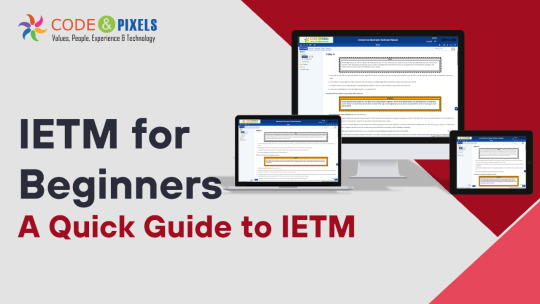
IETM: Interactive Electronic Technical Manual
Training Aids to Defence Client
If you are a supplier of defence then along with the system/equipment you also need to provide Training Aids
(CBT) — Computer-Based Training
Charts and Bloups
Video Film
Training Work Modules
Manuals Hard Copies
IETM
Evolution of Documentation in Defence
Before — Hardcopies and PDFs in DVDs (Upto 2015)
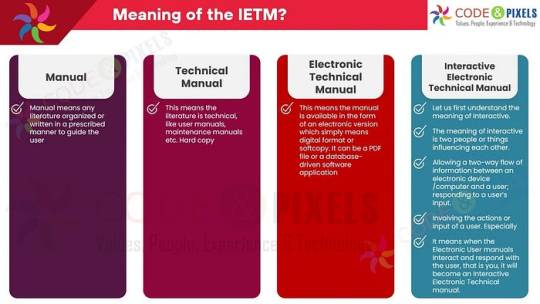
What is the meaning of the IETM?
Manual: Manual means any literature organized or written in a prescribed manner to guide the user.
TechnicalManual: This means the literature is technical, like user manuals, maintenance manuals etc. Hard copy
Electronic Technical Manual: This means the manual is available in the form of an electronic version which simply means digital format or softcopy. It can be a PDF file or a database-driven software application.
Interactive Electronic Technical Manual:
Let us first understand the meaning of Interactive. The meaning of interactive is two people or things influencing each other.
Allowing a two-way flow of information between an electronic device /computer and a user; responding to a user’s input.
Involving the actions or input of a user. Especially
It means when the Electronic User manuals Interact and respond with the user, that is you, it will become an Interactive Electronic Technical manual.
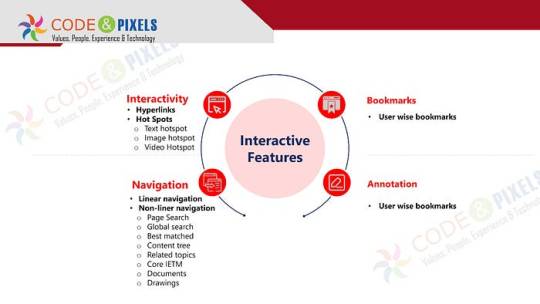
Interactive Features
Interactivity
Hyperlinks
Hot Spots
Text hotspot
Image hotspot
VideHotspot
Bookmarks
User wise bookmarks
Navigation
Linear navigation
Non-liner navigation
Page Search
Global search
Best matched
Content tree
Related topics
Core IETM
Documents
Drawings
Annotation
User wise bookmarks
The documents and pages are many hence, for easy and fast accessibility complete content is converted and stored as a database.
Whenever the user wants some information, IETM software produces the information in a fraction of a second.
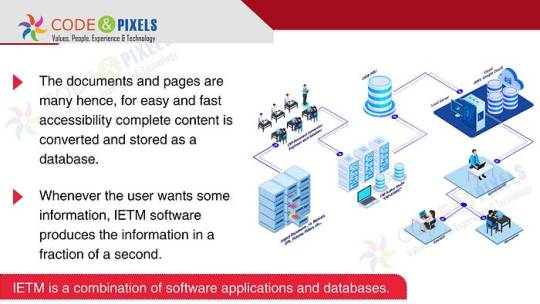
Use or Purpose of the IETM?
The purpose of the Manual is to give information related to the equipment to the end user for quick reference.
All the technicality is written in detail so that when an issue arises, the user can refer to the manual, as every time OEM or technical person or subject matter expert might not be available on the spot to resolve the issue.
If the manual has 10 pages users can refer easily.
But any system used by the defence will have multiple manuals and thousands of page counts and many times a user has to cross-refer between manuals, intra-manual and inter-manual to resolve the issue.
Referring to 10- 15 hard-copy or even soft-copy books simultaneously will be difficult and time-consuming.
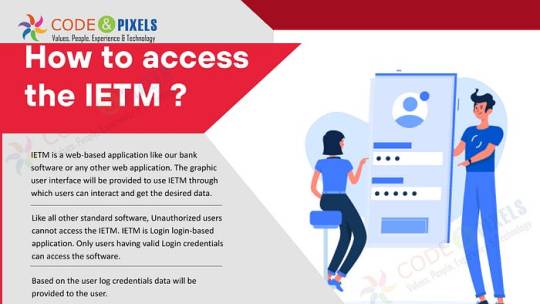
How to access the IETM ?
IETM is a web-based application like our bank software or any other web application. The graphic user interface will be provided to use IETM through which users can interact and get the desired data.
Like all other standard software, Unauthorized users cannot access the IETM. IETM is a Login - login-based application. Only users having valid Login credentials can access the software.
Based on the user log credentials data will be provided to the user.
IETM has 2 types of Users and one Administrator
Maintainer
Operator
If the operator logs in, the user gets all the content related to operator use, similarly if the maintainer logs in only maintenance-related content is visible for that user.
Ideally, all the content is available for both users, because the purpose of the IETM is to refer to the manual to fix the issue.
Administrators can create users who can see the user’s navigation and log-in history and interact with the users using user dashboards through Annotations.
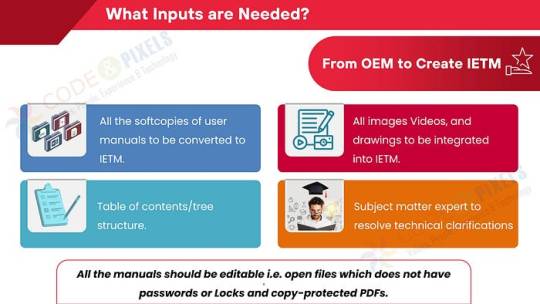
What Inputs are Needed? (From OEM to Create IETM)
All the softcopies of user manuals to be converted to IETM.
All images Videos, and drawings to be integrated into IETM.
Subject matter expert to resolve technical clarifications
Table of contents/tree structure.

Minimum Hardware Requirements?
NO High-end hardware or servers are required to run IETM.
However, if more concurrent users, then a good configuration server with good LAN connectivity must be ensured.
i3 with 8 GB RAM systems is the minimum configuration required for the server or for Node.
Deliverables
BASED DB (Manuals are covered in the Database)
IETM VIEWER Software
User Manual and Installation Manual
Standards — compliance
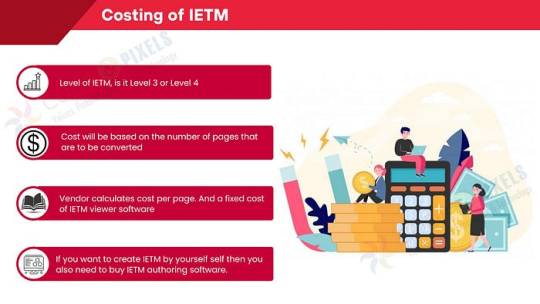
Costing of IETM: (Interactive Electronic Technical Manual)
Level of IETM, is it Level 3 or Level 4
Cost will be based on the number of pages that are to be converted
The vendor calculates the cost per page. And a fixed cost of IETM viewer software
If you want to create IETM by yourself self then you also need to buy IETM authoring software.
What are these Levels?
Level — 1 is any PDF file
Level — 2 is a PDF file with hyperlinks from the table of contents to the body etc.
Level — 3 is an HTML application. More hyperlinks, simple search, a content tree having log a screen with a hardcoded username and password and supplied in the format of EXE so that Windows can easily open
Level — 4 is Software plus Content/manuals converted as Database
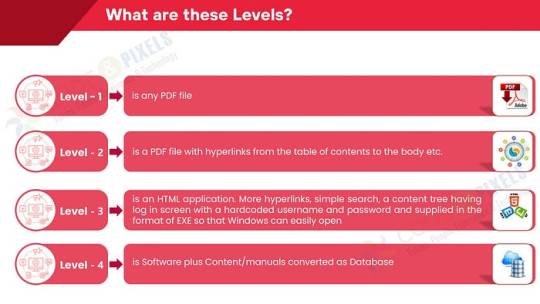
Regarding Level — 5, rest assured, till 2028 it will be Level — 4 only. As of now, there is nothing practically called Level — 5. Few are calling virtual reality and Augmented reality and Artificial intelligence Level — 5.
Pulling data from many user inputs and analyzing and giving results are done in Level — 5. IETM software cannot pull the data from various real-time points as No OEM will give the real-time information to third-party software directly. Yes, if the information is available offline, then that information can be imported into IETM and can be used as a reference.

#ietm#software#technology#ietm developement#ietm code and pixels ietm hyderabad#ietm software#elearning#code and pixels#ietm level iv#codeandpixels#ietm level 4 software requirements#technical documentation#ietm document#ietm documentation#interactive electronic technical manual#Ietm Service Providers#Ietm Software Designers of India#Software Development Company#Elearning Solutions Company#E Learning Content Development Company#Online Education#Digital Education#Digital Content#Software Development Solutions#Elearning#Ietm Developers#Econtent Development#Elearning Solutions Providers#Econtent Developers#Econtent
3 notes
·
View notes
Text
Prologic Technologies specializes in creating best web solutions to meet your unique business needs. Our bespoke approach ensures that every aspect of our services aligns perfectly with your requirements, empowering your organization to thrive in today's dynamic market environment.
#prologictechnologies#custom ecommerce applications#website development#custom telemedicine solution provider#software development#SaaS based E-learning Platforms Services
0 notes
Text

🚀 Ready to take your career to the clouds? ☁️
Join our Cloud Computing Master Program at eMexo Technologies and get ahead in one of the hottest fields in tech! 🌐 With 40% OFF for a limited time, there's never been a better time to upgrade your skills. 🎯
✨ Transform your future with hands-on experience and expert instructors. Don't miss this opportunity! 💼
👉 CLICK THE LINK FOR COURSE INFO: https://www.emexotechnologies.com/courses/cloud-masters-program-certification-training-course/ to enroll now and take advantage of this massive discount! 🔥
📅 9th Sept 2024 🧭 9 AM ( IST )
Format: Online Training
Contact Us For More Info:
📞 Phone: +91 9513216462
🌐 Website: https://www.emexotechnologies.com/
#cloudcomputing#cloud computing training#tech education#certification course#tech skills#e learning#learn to code#careerdevelopment#career growth#emexotechnologies#emexotechnologies bangalore electroniccity bangalore#it training institute#software training institute#it training courses
0 notes
Text

In today’s fast-evolving work environment, businesses face increasing pressure to stay compliant with industry regulations while continuously enhancing employee skills to remain competitive. Workforce training solutions that effectively address both regulatory compliance and upskilling are no longer optional — they are essential to sustainable business growth and operational excellence.
Why Regulatory Compliance Training Matters
Regulatory compliance training ensures that employees understand and adhere to the laws, guidelines, and standards relevant to their roles. Whether it's OSHA regulations in manufacturing, HIPAA in healthcare, GDPR in data management, or financial compliance in banking, non-compliance can lead to costly fines, legal issues, and reputational damage.
Effective compliance training:
Minimizes legal and financial risks
Builds a culture of accountability and integrity
Boosts employee awareness and confidence in handling sensitive tasks
Enhances public and stakeholder trust
For More Details : https://www.sevnest.com/
+91 638 375 5273
#corporate elearning solutions#best hr compliance software#hr compliance courses#human resource software solution#elearning service provider#hr compliance courses with certificate#online employee training program#hr compliance e-learning solutions#hr compliance software solutions#hr compliance training for employees
0 notes